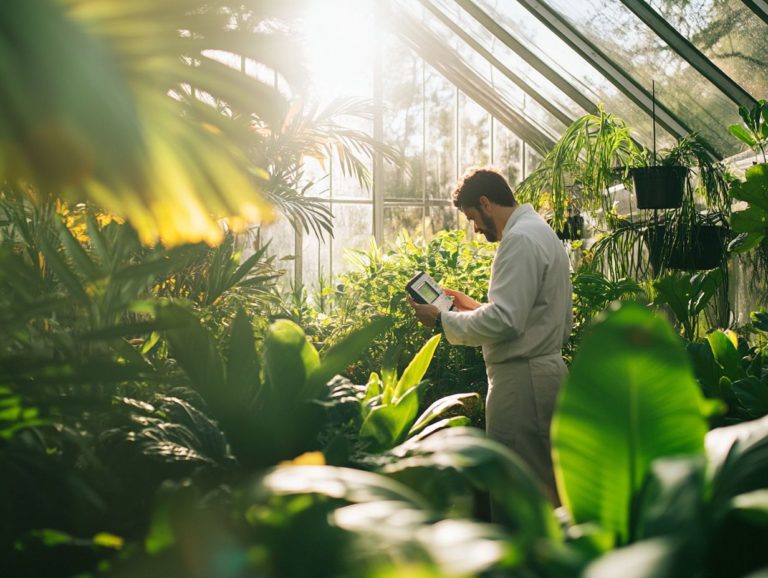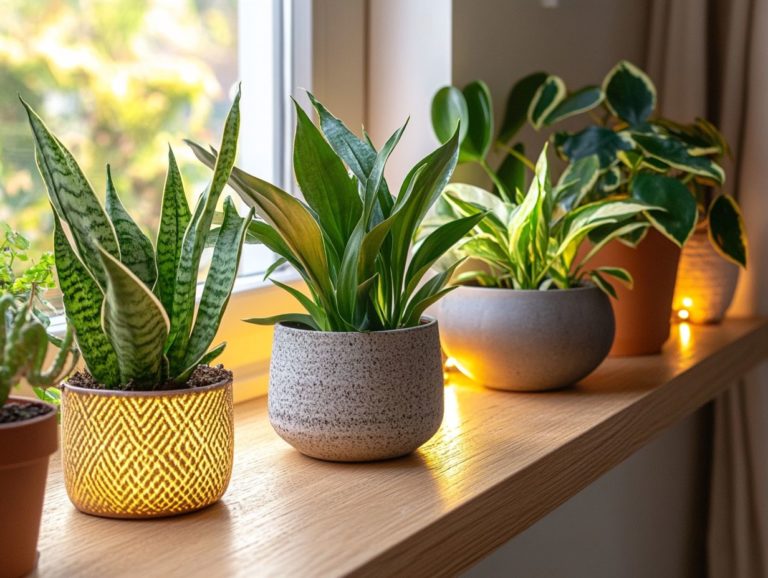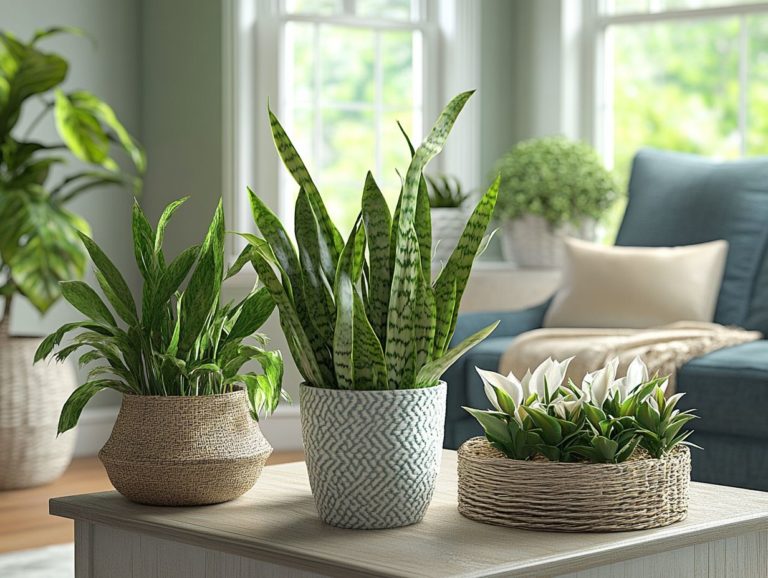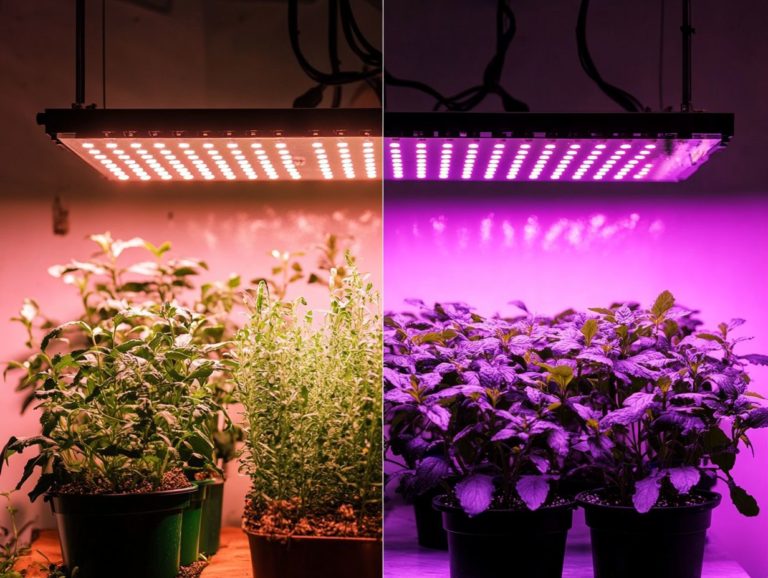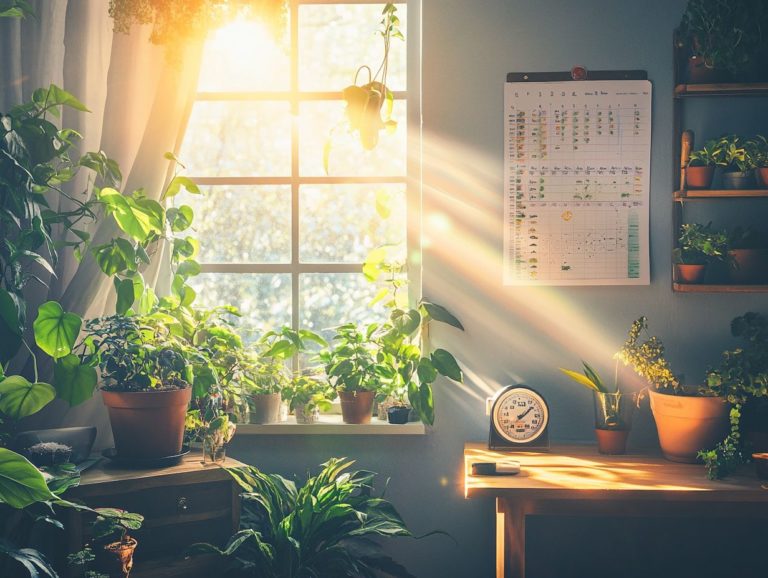Adjusting Light for Healthier Plants
Light plays a vital role in the health and growth of your plants, impacting everything from photosynthesis to flowering.
This article delves into the types of light that can benefit your greenery and highlights the signs that suggest they might be lacking in this essential resource.
You’ll discover how to fine-tune light conditions whether through natural sunlight or artificial sources to nurture vibrant, thriving plants.
Key factors to keep in mind include the specific plant species and their growth stages. This ensures you have all the necessary tools for successful gardening.
Contents
- Key Takeaways:
- Understanding Light for Plants
- Signs of Inadequate Light
- How to Adjust Light for Healthier Plants
- Using Artificial Light for Plants
- Factors to Consider for Light Adjustment
- Frequently Asked Questions
- What is the importance of adjusting light for healthier plants?
- How do I know if my plants are receiving enough light?
- Can I use artificial light for my plants?
- How can I adjust light for indoor plants?
- What happens if my plants don’t get enough light?
- How can I adjust light for plants that require shade?
Key Takeaways:
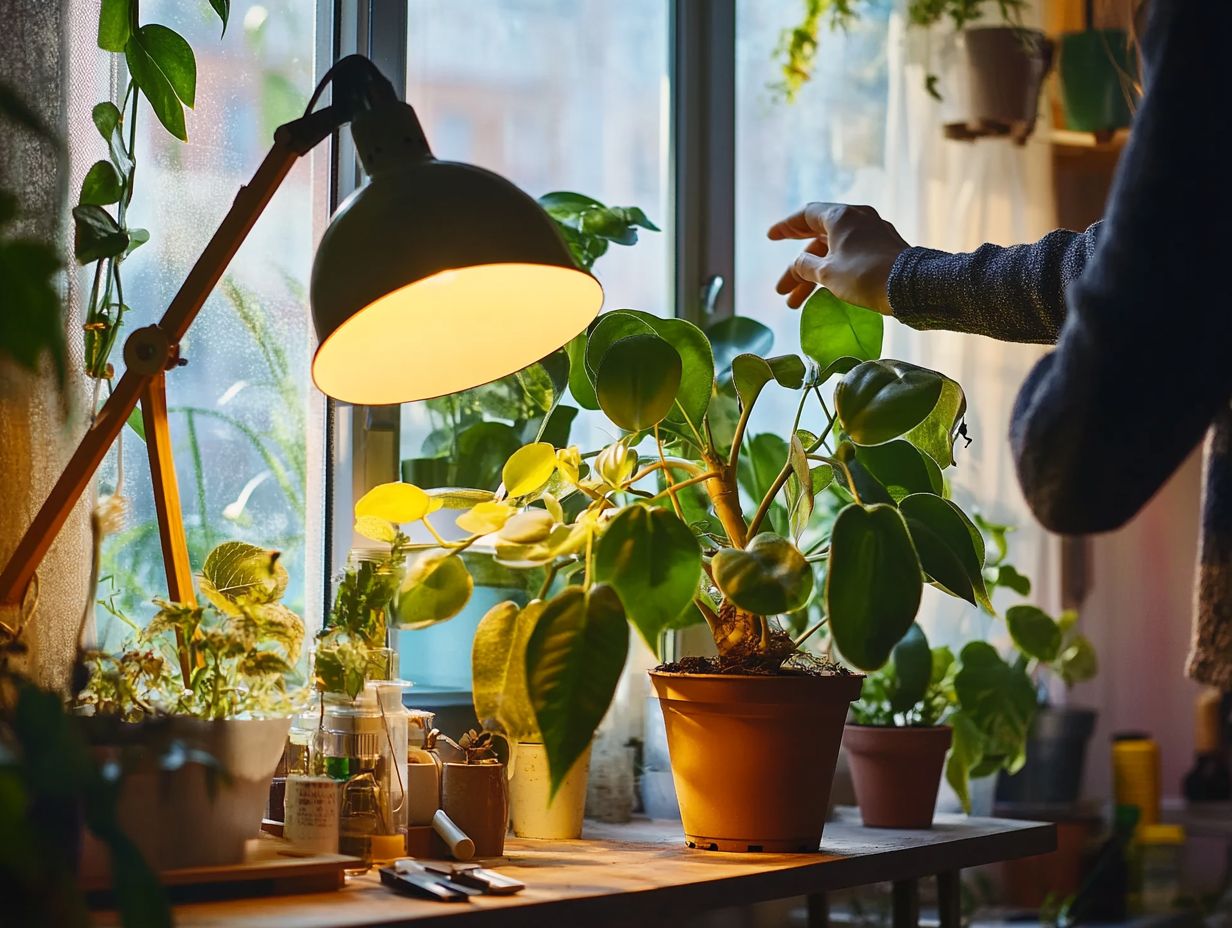
- Understanding light is crucial for healthy plant growth.
- Identifying and addressing light deficiencies is key to preventing stunted growth and other plant health issues.
- Consider factors like plant species, growth stage, and environmental conditions when adjusting light for optimal health.
Understanding Light for Plants
Understanding the basics of light for your plants is crucial for mastering indoor gardening. If you’re eager to cultivate an array of indoor beauties from houseplants to flowering specimens and decorative choices the right lighting conditions can greatly influence plant growth.
This results in lush foliage, striking colors, and vigorous development. Factors such as light intensity, duration, and quality can vary considerably, making it essential for you to understand how different light sources like LED and fluorescent bulbs affect your plants’ growth journey.
Types of Light and Their Effects on Plants
Several types of light play a vital role in the growth and health of your plants, including natural light and various forms of artificial lighting like LED bulbs, fluorescent bulbs, and incandescent lights.
Understanding the unique light spectrum emitted by each source is essential for optimizing photosynthesis, which is how plants make their food using sunlight. For example, LED bulbs are energy-efficient and can be customized to emit specific wavelengths tailored to your plants’ needs during different growth stages.
While fluorescent bulbs may not be as energy-efficient, they provide a broader spectrum, making them ideal for seedlings and low-light plants. Incandescent lights, though less common in today s gardening practices, offer warmth that can benefit certain flowering plants.
When selecting lighting, consider the type of plant and its growth stage. Flowering plants typically thrive under a stronger blue and red light spectrum to encourage blooming. For more information on identifying light needs of various plants, assess your plants’ specific needs to choose the right light source, ensuring robust growth and lush foliage.
Signs of Inadequate Light
Recognizing the signs of inadequate light is crucial for maintaining the health of your indoor garden. Your plants depend significantly on proper light exposure for photosynthesis and overall growth.
When they don’t get enough light, you’ll notice symptoms such as stunted growth, leggy stems, and discolored leaves. These issues suggest that your plants aren t receiving the ideal balance of high, low, or medium light, particularly during seasonal shifts that can alter light conditions.
Start adjusting your plants’ light today for a healthier garden!
Identifying and Addressing Lack of Light
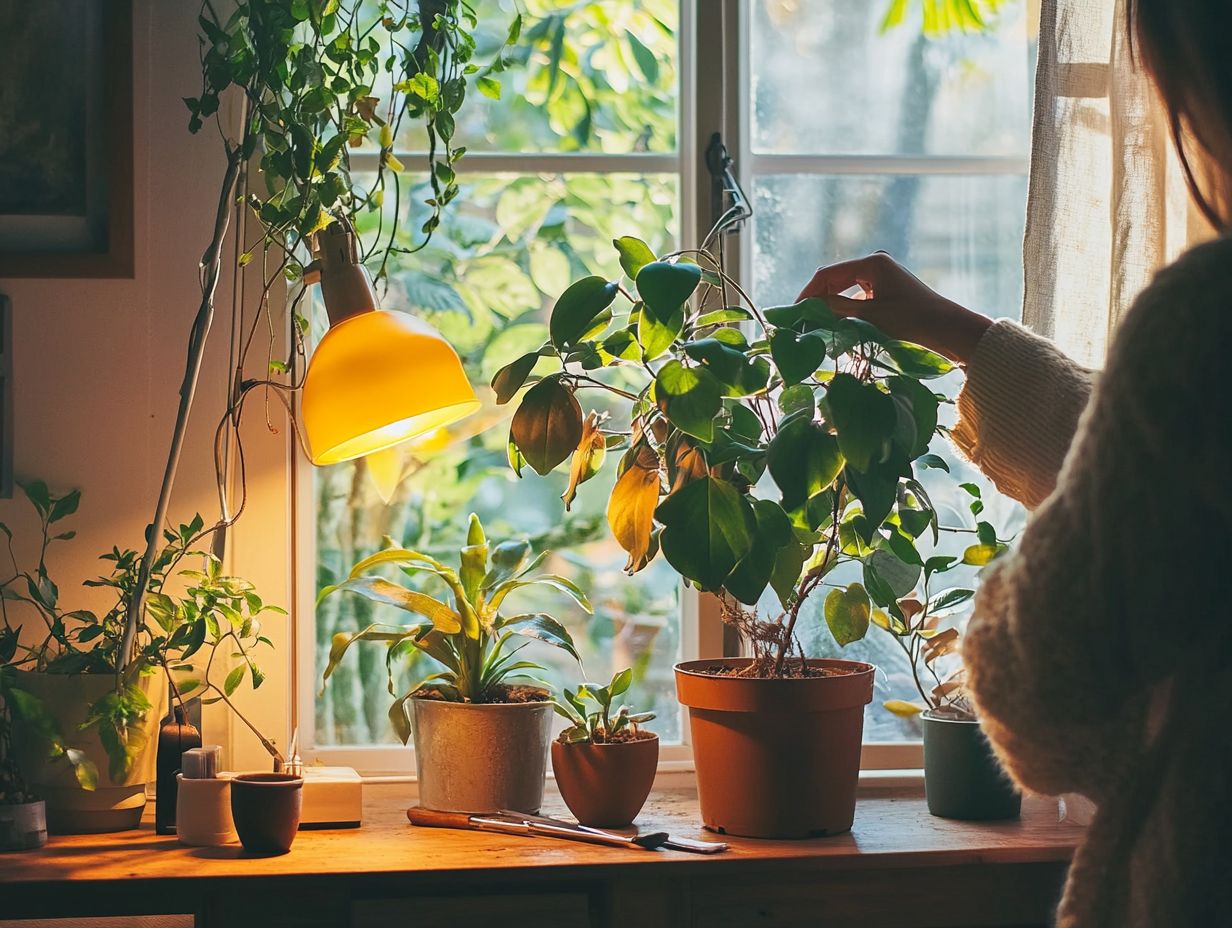
Identifying and addressing lack of light in your indoor garden is crucial for thriving plants. A light meter is a tool that measures how much light reaches your plants, helping you adjust their placement effectively.
To use a light meter, take readings at different times of the day and in various locations. This will help you understand whether the light is bright, medium, or low.
If your readings suggest insufficient light, consider using reflective surfaces like mylar or white walls. You can also adjust hanging pendants to enhance light in shaded areas.
By recognizing the specific light needs of your plants, you ensure they receive adequate intensity. This ultimately leads to more vibrant growth and development.
How to Adjust Light for Healthier Plants
Adjusting light for healthier plants is a key part of mastering indoor gardening. Proper light can significantly impact their growth, flowering, and overall vitality.
Understanding various lighting strategies helps you create a supportive environment. Use supplemental lighting and optimize mirror placement to enhance growing conditions.
Methods for Increasing or Decreasing Light
Numerous ways exist to increase or decrease light exposure for your plants. Consider options like hanging pendant lights or repositioning your plants to maximize light access.
During the winter months, move houseplants closer to south-facing windows to capture more direct sunlight. You can also use full-spectrum grow lights above your plants to mimic natural sunlight in shady spots.
Light-reflective surfaces, such as mirrors or light-colored walls, can enhance ambient light. These adjustments help your green companions flourish and create a vibrant living space.
Using Artificial Light for Plants
Using artificial light is a great way to promote optimal growth, especially in areas with limited natural sunlight. This is particularly useful during winter or in less sunny spots.
Grow lights, like LED and fluorescent bulbs, offer many benefits. They allow you to tailor the light spectrum to your plants’ needs and improve lighting in greenhouse setups.
Types of Artificial Light and Their Benefits

The types of artificial light you can choose for indoor gardening include LED, fluorescent, and incandescent bulbs. Each type offers unique benefits tailored to various plant types and growth needs.
LED lights are energy-efficient and provide a broad light spectrum that mimics sunlight, encouraging healthy food production in plants. Fluorescent bulbs are often chosen for their affordability and effective light output.
While incandescent bulbs may not be the most energy-efficient option, they emit warmth that can aid seedlings in cooler environments. However, their limited light spectrum may not support plant growth as effectively during later stages.
Each lighting type comes with specific considerations regarding placement and duration of exposure. For example, during the vegetative stage, a full-spectrum LED can significantly enhance growth. Fluorescent fixtures are ideal for starting seeds due to their gentle light intensity.
Improper use of incandescent bulbs can create too much heat, hindering growth. This highlights the importance of selecting the right light type for each growth phase.
Factors to Consider for Light Adjustment
It s exciting to explore a few key factors that can boost your indoor plants: the species of the plant, its growth stage, and the overall environmental conditions.
Each plant type has its own unique light preferences. For example, some flourish in bright, high light, while others are more comfortable in low light settings. Choosing the right light for house plants and tailoring the light exposure to meet these needs is essential for fostering optimal plant health.
Plant Species, Growth Stage, and Environmental Factors
Understanding how plant species, growth stages, and environmental factors interact is crucial for mastering light management in your indoor garden. Each plant, whether it s Aglaonema or Dracaena, has unique light needs that evolve as they grow.
For instance, Aglaonema thrives in low to medium light, making it perfect for dimly lit corners. However, as it matures, its need for brighter light increases, promoting growth and enhancing vibrant leaf patterns. On the other hand, Dracaena requires bright, indirect light and can become leggy without sufficient lighting.
During the seedling stage, many plants benefit from gentler lighting to avoid scorching. In contrast, mature plants often thrive under more intense exposure to support their growth.
By utilizing adjustable grow lights and periodically rotating your plants, you can create a balanced environment that meets their changing light requirements. This approach fosters healthier, more resilient plants in your indoor sanctuary.
Frequently Asked Questions
What is the importance of adjusting light for healthier plants?
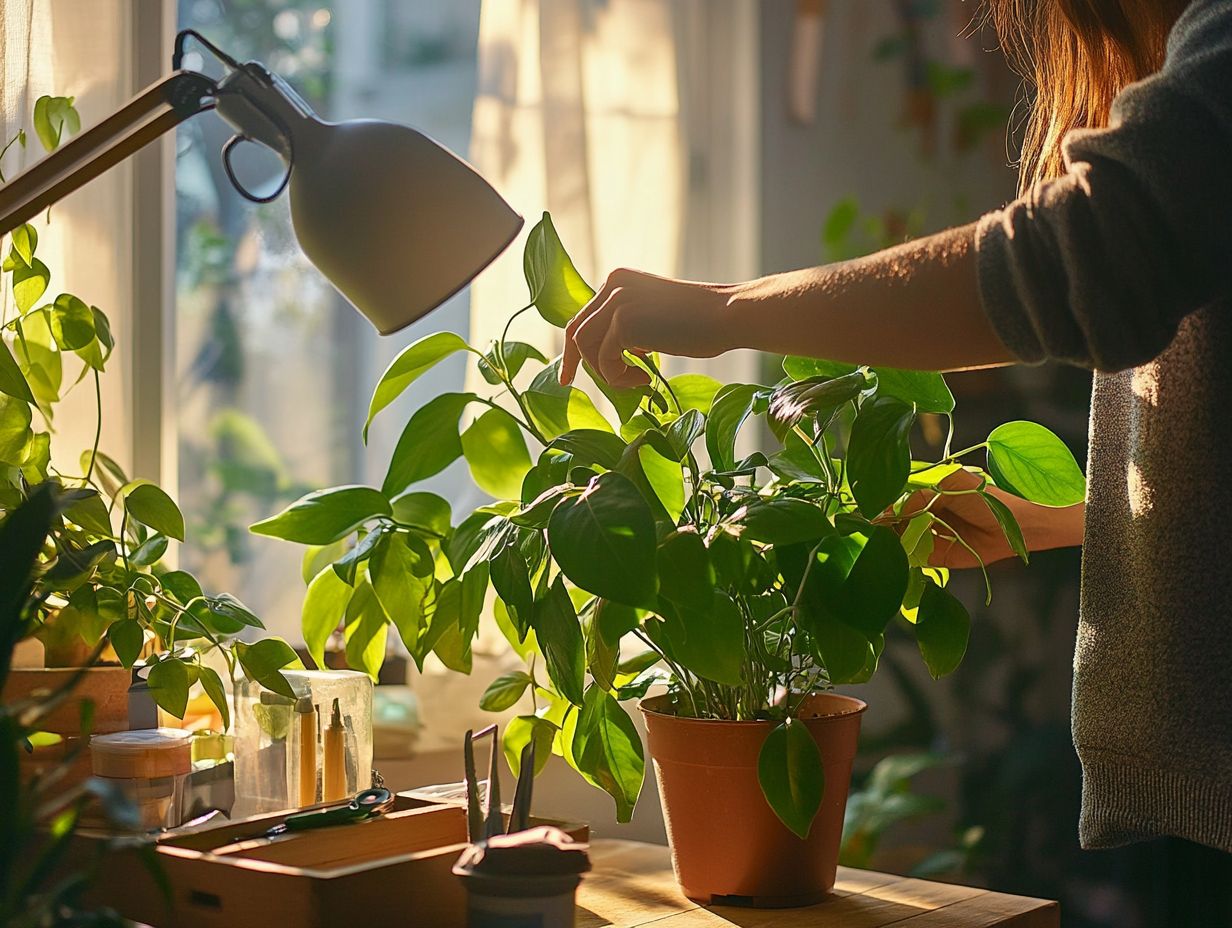
Adjusting light for healthier plants is crucial for their growth and development because light plays a significant role in how plants make their food. It provides energy for plants to produce food and helps regulate their internal processes.
How do I know if my plants are receiving enough light?
One way to tell if your plants are getting enough light is by observing their color. If they are dark green and appear stretched or spindly, they may not be receiving enough light. Conversely, if they are yellowish, it could indicate too much light.
Can I use artificial light for my plants?
Yes! Artificial light can supplement natural light for your plants. However, it s essential to choose the right type of light, such as fluorescent or LED, and adjust the distance and duration of lighting according to your plants’ needs.
How can I adjust light for indoor plants?
To adjust light for indoor plants, you can move them closer to a window or provide additional artificial light. Be sure to rotate them regularly to ensure all parts of the plant receive adequate light.
Don t wait! Adjust your plants light now to see them thrive!
What happens if my plants don’t get enough light?
Are your plants struggling to thrive? If they do not receive enough light, they will have stunted growth and smaller leaves.
This makes them more susceptible to diseases and pests, and in severe cases, they may even die. Ensure your plants get the right amount of light for optimal health!
How can I adjust light for plants that require shade?
Wondering how to protect your shade-loving plants? They can be placed in areas with less direct light or covered with shade cloth.
Using curtains or blinds to filter sunlight is also a great option. Always research your plant s specific needs to ensure it gets the right amount of light!

